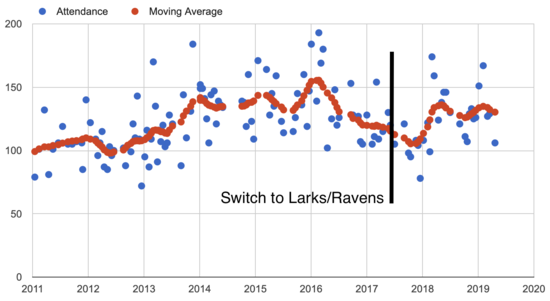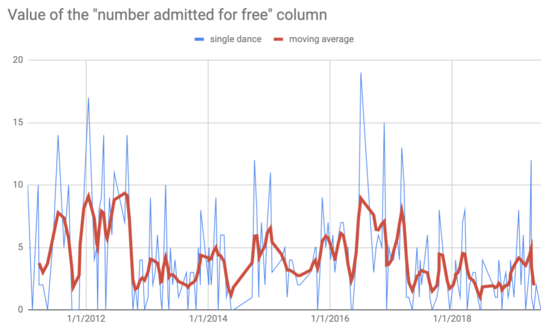Larks/Ravens and Newcomers |
July 8th, 2019 |
| contra, roles |
BIDA switched to Larks/Ravens two years ago after about eight years of Gents/Ladies. While to experienced dancers Larks/Ravens was a change, to newcomers that's just the way the dance is.
Things mostly seem pretty similar to before the change: we still have lots of newcomers and not that many come back and become regulars. Attendance is pretty noisy but doesn't seem to have been affected:
I have noticed some smaller changes, though:
-
During our beginner workshop people choose roles close to randomly and don't end up disproportionately in male-female couples or with men dancing Lark and women dancing Raven. Once the dance starts the newcomers notice that while the caller said anyone can dance any role in practice there are more men in one role and more women in the other. Through some sort of a combination wanting to do the normal thing for their gender and ending up in male-female couples where the other person in the couple wants to dance the traditional role for their gender, most of them move to male-Lark/female-Raven over the first few dances. One male dancer I talked to who had happened to spend the workshop practicing the Raven role was confused why we hadn't told him that Raven was the women's role, since he would have preferred to be practicing the role he would end up dancing.
One idea here would be to encourage our callers to explicitly teach both roles at the workshop? For most of the workshop the two roles do the same thing, so mostly this would mean showing people both halves of Ravens Chain, Right and Left Through, and Swing.
When a new couple accidentally swaps, generally by ending the swing with the Lark on the right, people just dance with them positionally. This means some people end up bouncing back and forth between the roles a bit at first. This seems like it's probably confusing, but the thing where experienced dancers would try and unswap you while the dance was moving was also confusing so I'm not sure it's much worse.
-
Dancers who do choose to dance the role that's not traditional for their gender have much more success. When our dance was Gents/Ladies we were pretty far towards the accepting end of anyone can dance any role. No one ever gave me a hard time at BIDA about dancing Lady and I often danced "swapped" (female-Gent/male-Lady) and in male-male couples. A big part of why this wasn't a problem for me, however, was that I already knew how to dance well. I would be in the right place at the right time with a smile and my hand out, and that was enough of an "yes, I'm the Lady" signal that everything went well.
When newcomers tried to dance "swapped" it didn't go as well. The other dancers would pick up on them being new, and many would make the reasonable but unhelpful inference that they were probably swapped and try to unswap them. Most now dancers would come away from this with the idea that "anyone can dance any role" wasn't right and just start dancing male-Gent/female-Lady, but I remember a few cases where dancers came up to me as an organizer to ask what to do about peoplke continually trying to "put them back where they should be".
Even before switching to Larks/Ravens our dance had enough experienced dancers who danced both roles that gender presentation was a misleading for whether someone was dancing Gent or Lady. Some new dancers would get confused, because, say, they would hear "Gents Allemande left" and try to Allemande left with the other man when it was really that person's female partner who was dancing Gent.
I was curious whether I could also look at this quantatatively. Are newcomers more or less likely to come back now? We give out passes to new dancers who arrive in time for the workshop which let you get in free at a future dance. I thought I'd graph the numbers for "people admitted for free" from our attendance spreadsheet, which is generally redemption of these passes, and should be a rough proxy for propensity to return:
Unfortunately, I think this data isn't very useful. The sharp drop after the 2012-09-16 dance was due to us switching from "first time free" to "second time free", so that makes sense. But looking back over our board emails, the other times it's been higher have often been times when door volunteers have been admitting newcomers for free, either because they misunderstood the policy or the hall manager training them did. The sharp drop at 2017-04-16 is suspiciously close to when we started trying Larks/Ravens, but it's before we made the switch. It's also a dance where we had a lot of board members around (annual meeting) so I think the most likely thing was that this was one of the times when we noticed people were being admitted free when they shouldn't be. It seems like this data isn't good enough to give us useful insight into whether newcomers are more or less likely to come back.
Overall I haven't noticed large changes, and newcomers still seem to generally do about as well as they did before. The "Larks on the left, Ravens on the right" alliteration seems somewhat helpful, but not a large difference. While some experienced dancers in communities that are considering Larks/Ravens have worried that it will be harder for newcomers, that's not what we've seen. On the other hand our dance already had a lot of people dancing whatever role they wanted, and at a dance with a strong male-Gent/female-Lady culture I do think things would be different.
Comment via: facebook, substack

